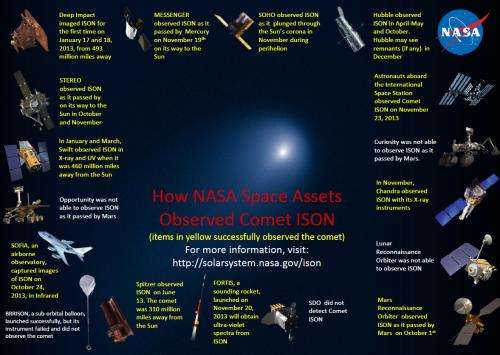NASA begins search for what is left of Comet ISON

Just prior to its closest approach to the sun on November 28, Comet ISON went through a major heating event, and likely suffered a major disruption. At this time, scientists are not sure how much of the comet survived intact. We may be seeing emission from rubble and debris in the comet's trail, along its orbit, or we may be seeing the resumption of cometary activity from a sizable nucleus-sized chunk of ISON.
Most agree that ISON was destroyed (with greater than 90% probability of this having occurred), leaving behind small (< 10 m radius) pieces of rubble, but perhaps, with maybe 10% probability of occurring, also leaving behind some important fragments 100m radius or larger, big enough to study. If previous sungrazing comets are any guides, there may be a sizeable piece of comet nucleus left. At this point, though, scientists are waiting for a variety of telescopes to make observations before the status of Comet ISON can be confirmed.
What remains of Comet ISON appears to brighten and spread out, then fade. The disappearance of a strong central brightness condensation after perihelion is telling, the comet is clearly fainter and more diffuse going out than going in, but it continues to shine. The spread out light is likely due to dust emitted in the few hours before perihelion going around the sun.
We have seen comets come close to the sun and disrupt and disappear before, like Comets Lovejoy and Elenin in 2012. We have also seen them survive in much smaller pieces, like the Kreutz sungrazer family progenitor and Comet Kohoutek in 1973.
Twelve NASA spacecraft and the International Space Station have observed and detected Comet ISON on its multi-million year journey from the Oort Cloud to the solar corona.
What NASA will be doing in the next days to clarify ISON's status:
- NASA will monitor the comet for the next several weeks. If there is nothing sizable and stable left, it will dissipate and disappear in this time, as already emitted dust leaves the vicinity. If there is still a central source of emission, even if it is very much smaller, we will see a new, much fainter coma and tail form, which currently may be overwhelmed by the dust emitted from before the disruption event.
- NASA's STEREO spacecraft will be using their cameras to search for bright fragments throughout the week, while the NASA Infrared Telescope Facility (IRTF) in Honolulu, Hawaii will use its 3m wide telescope to detect the comet spectroscopically, the same way it did on ISON's inbound journey. Radio telescopes around the world will also be able to tell us more about what has happened. NASA's recently launched MAVEN spacecraft may try to observe ISON next week. By mid- to late-December NASA's Hubble and Chandra observatories will be performing deep outer space searches for any remnants of the comet. Spitzer will also look for ISON in early 2014.
If a fragment that acts like a comet is detected, but at a much reduced level, it may be hard to see it from the Earth at the time of its closest approach on December 26, 2013.
Provided by NASA's Goddard Space Flight Center




















